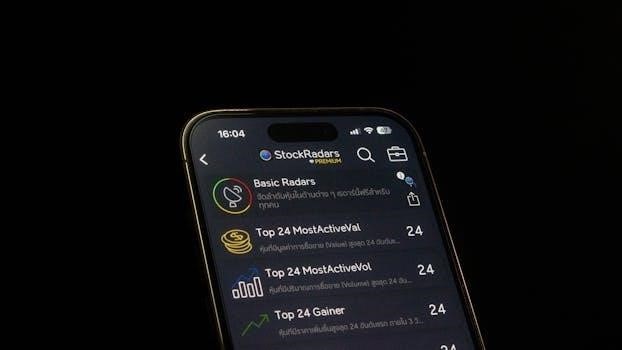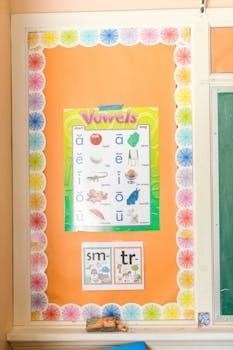Figurative Language Anchor Chart PDF⁚ A Comprehensive Guide
Figurative language anchor charts are vital tools for educators. They help students grasp complex literary concepts. These charts offer clear definitions and examples. They cover simile, metaphor, personification, hyperbole, onomatopoeia, and alliteration, enhancing comprehension and creativity in writing and analysis.
Figurative language anchor charts serve as essential visual aids in classrooms, particularly for elementary, middle, and high school students. These charts introduce and reinforce figurative language concepts, making them more accessible and understandable. They act as a constant reference point, reminding students of key definitions and examples related to simile, metaphor, personification, hyperbole, onomatopoeia, and alliteration.
These charts are designed to foster creativity and improve comprehension by presenting abstract concepts in a clear and engaging manner. Teachers utilize them to introduce new topics or review previously learned material, ensuring students can easily identify and interpret figurative language in texts.
Anchor charts support diverse learning styles by combining visual and textual elements. They facilitate interactive lessons and cooperative activities, allowing students to actively engage with the material. Available in printable and editable formats, these charts can be customized to meet specific classroom needs. By using figurative language anchor charts, educators create a dynamic learning environment where students can confidently explore the nuances of language and literary expression, enhancing their overall literacy skills.

What is Figurative Language?
Figurative language is language that uses words or expressions with a meaning that is different from the literal interpretation. It enhances writing by creating vivid imagery, evoking emotions, and making abstract ideas more concrete. Unlike literal language, which means exactly what it says, figurative language invites readers to understand the underlying meaning or message.
Common types of figurative language include simile, which compares two things using “like” or “as”; metaphor, which directly equates two unlike things; personification, which gives human qualities to inanimate objects or animals; hyperbole, which exaggerates for emphasis or effect; onomatopoeia, which uses words that imitate sounds; and alliteration, which repeats initial consonant sounds in adjacent words.
Figurative language is used to add depth and complexity to texts, making them more engaging and memorable. It allows writers to express ideas in a creative and imaginative way, and it challenges readers to think critically and interpret the intended meaning beyond the surface level. Mastering figurative language is essential for both understanding and producing effective and compelling writing.
Why Use Anchor Charts for Figurative Language?
Anchor charts serve as invaluable visual aids in the classroom, especially when teaching abstract concepts like figurative language. They provide a clear and concise reference point for students, helping them to understand and remember different types of figurative language such as simile, metaphor, personification, hyperbole, onomatopoeia, and alliteration. By presenting definitions, examples, and visual cues, anchor charts make these concepts more accessible and engaging for learners.
These charts are particularly effective because they are created collaboratively with students, fostering a sense of ownership and investment in the learning process. As students participate in the creation of the anchor chart, they actively engage with the material, reinforcing their understanding. Moreover, anchor charts remain visible in the classroom, serving as a constant reminder and support for students as they encounter figurative language in various texts.

Anchor charts also promote independence by empowering students to refer back to the information whenever they need clarification or a quick review. This reduces reliance on the teacher and encourages self-directed learning, ultimately enhancing students’ ability to identify and interpret figurative language effectively.
Key Types of Figurative Language Covered in Anchor Charts
Figurative language anchor charts typically cover several essential types of figurative language. Similes, which compare two things using “like” or “as,” are a common feature, helping students differentiate them from metaphors. Metaphors, another key element, directly equate two unlike things without using “like” or “as,” enhancing students’ understanding of implied comparisons.
Personification, the attribution of human qualities to inanimate objects or animals, is also frequently included, encouraging students to recognize and analyze how this technique brings vivid imagery to writing. Hyperbole, the use of exaggeration for emphasis or effect, helps students understand how overstatement can create humor or highlight a point.
Onomatopoeia, where words imitate sounds, is another type often featured, aiding students in recognizing the auditory dimension of language. Alliteration, the repetition of initial consonant sounds in adjacent words, is also commonly covered, assisting students in identifying patterns of sound that enhance rhythm and memorability. These anchor charts provide definitions, examples, and visual cues for each type, supporting students in mastering these key literary devices.
Simile
A simile is a figure of speech that directly compares two different things using the words “like” or “as.” It’s a tool that writers use to create vivid imagery and make descriptions more engaging for the reader. Similes help to paint a picture in the reader’s mind by drawing a connection between something familiar and something new or less known. The purpose is to enhance understanding or emphasize a particular quality by associating it with something else.
For example, “The stars sparkled like diamonds in the night sky” is a simile that compares the brightness of stars to the brilliance of diamonds. Another example is, “He ran as fast as a cheetah,” which emphasizes the person’s speed by comparing it to the swiftness of a cheetah. Similes are a fundamental element of figurative language, commonly taught in elementary and middle school to help students understand and appreciate the nuances of descriptive writing. Anchor charts often include similes to provide clear examples and reinforce this concept.

Metaphor
A metaphor is a figure of speech that directly equates one thing to another without using “like” or “as,” asserting that one thing is something else to imply a resemblance. Unlike similes, metaphors do not make a direct comparison using connecting words; instead, they create a stronger, more implicit connection. This literary device is used to add depth and color to writing, helping readers understand a subject in a new and imaginative way. Metaphors are powerful tools for making abstract concepts more concrete and relatable.
For instance, saying “Time is a thief” is a metaphor that suggests time steals away moments and opportunities, just as a thief steals physical possessions. Another common example is “The world is a stage,” which implies that life is a performance and people are merely actors. Metaphors are crucial in literature and everyday language, and anchor charts often feature them to illustrate how they transform ordinary expressions into more evocative and meaningful statements. Understanding metaphors enhances reading comprehension and creative writing skills.
Personification
Personification is a type of figurative language where human qualities, feelings, actions, or characteristics are attributed to non-human objects, animals, or ideas. This literary device allows writers to bring inanimate things to life, making them relatable and understandable to readers. By giving human traits to non-human entities, personification can create vivid imagery and evoke emotional responses, enhancing the overall impact of a text.
For example, saying “The wind whispered secrets through the trees” is personification because the wind, an inanimate force, is described as whispering, a human action. Another instance is “The sun smiled down on the earth,” attributing the human emotion of smiling to the sun. These examples demonstrate how personification can transform ordinary descriptions into more engaging and imaginative expressions. Anchor charts often highlight personification with clear definitions and examples, aiding students in recognizing and using this technique to enrich their writing and comprehension.
Hyperbole
Hyperbole is a figure of speech that involves the exaggeration of a statement for emphasis or effect. It’s not meant to be taken literally but rather to create a memorable or humorous impression. Hyperboles are used to amplify a point, making it more noticeable or impactful. They add color and flair to both writing and speech, engaging the audience by presenting ideas in an over-the-top manner. This technique is common in everyday conversations, literature, and advertising, where the goal is to capture attention and leave a lasting impression.
For example, saying “I’m so hungry I could eat a horse” is a hyperbole because no one can literally eat an entire horse. Similarly, “I’ve told you a million times” is an exaggeration to emphasize the frequency of a repeated instruction; Anchor charts often feature hyperboles to illustrate their use in context, helping students identify and appreciate this type of figurative language. By understanding hyperboles, students can enhance their ability to interpret texts and create more expressive writing.
Onomatopoeia
Onomatopoeia refers to words that imitate or resemble sounds. These words bring a sensory dimension to writing, allowing readers to “hear” the actions or objects being described. Examples include “buzz,” “hiss,” “meow,” and “splash.” Onomatopoeia is frequently used in poetry, comics, and children’s literature to make narratives more vivid and engaging. By incorporating sound effects, writers can create a more immersive experience for their audience.
Anchor charts dedicated to onomatopoeia typically feature a variety of words that represent different sounds. These visual aids help students recognize and use onomatopoeia effectively in their own writing. Understanding onomatopoeia enhances a student’s ability to appreciate the nuances of language and the creative ways in which words can mimic real-world phenomena. Teachers often use interactive activities to encourage students to identify and generate onomatopoeic words, reinforcing their understanding and promoting imaginative expression. Onomatopoeia adds a layer of sensory detail, making the writing experience richer and more memorable.
Alliteration
Alliteration is the repetition of the same initial consonant sound in a series of words. This technique is used to create a musical or rhythmic effect, making phrases more memorable and appealing. Common examples include “Peter Piper picked a peck of pickled peppers” and “Sally sells seashells by the seashore.” Alliteration is frequently employed in poetry, advertising, and tongue twisters to enhance the auditory experience and add emphasis to particular words or phrases;
Anchor charts for alliteration highlight this concept with clear examples and explanations. These visual aids assist students in identifying and using alliteration in their writing. Recognizing alliteration helps students appreciate the sound qualities of language and how they contribute to the overall impact of a text. Teachers often engage students in activities where they create their own alliterative phrases, reinforcing their understanding and encouraging creative expression. Alliteration not only makes writing more engaging but also aids in memorization, making it a valuable tool for writers.
Creating Effective Figurative Language Anchor Charts
Crafting effective figurative language anchor charts involves several key steps. First, clarity is paramount; definitions should be concise and easy to understand. Include relevant examples for each type of figurative language, such as similes, metaphors, personification, hyperbole, onomatopoeia, and alliteration. Visual appeal is also crucial. Use bright colors, engaging images, and a well-organized layout to capture students’ attention.
Consider incorporating a cooperative activity to make the chart interactive. This could involve students adding their own examples or definitions. Ensure the chart is accessible and visible in the classroom, serving as a constant reference point. Regularly update the chart with new examples or student contributions to keep it relevant. Free downloadable templates can provide a starting point, but customization is key. Tailor the chart to your students’ specific needs and learning styles. A well-designed anchor chart reinforces understanding and promotes effective use of figurative language in writing.
Using Figurative Language Anchor Charts in the Classroom
Figurative language anchor charts are invaluable for classroom instruction. Introduce each type of figurative language using the chart as a visual aid. Encourage students to identify examples in texts and explain their meanings. Incorporate the chart into writing activities, prompting students to use similes, metaphors, and other devices in their own work. Regularly refer to the chart during lessons to reinforce concepts and clarify misunderstandings.
Create interactive activities where students add examples or identify figurative language in sentences. Use the anchor chart as a reference during peer review sessions, helping students provide constructive feedback. Consider having students create their own mini-charts to demonstrate understanding. Make the anchor chart a central part of your figurative language unit. Use it to guide discussions, activities, and assessments. By integrating the chart into daily instruction, you enhance students’ comprehension and application of figurative language, fostering creativity and analytical skills. This approach transforms abstract concepts into practical, usable knowledge.
Free and Printable Figurative Language Anchor Chart Resources

Numerous free and printable figurative language anchor chart resources are available online for educators. Websites like Teachers Pay Teachers offer a variety of charts created by teachers, covering simile, metaphor, personification, hyperbole, onomatopoeia, and alliteration. These resources often include colorful designs and clear examples, making them visually appealing and easy to understand for students.
Many educational blogs and websites provide downloadable PDF versions of anchor charts that can be printed and used in the classroom. Some resources offer customizable templates, allowing teachers to tailor the charts to their specific curriculum needs. Be sure to look for resources that align with your grade level and learning objectives. Consider laminating printed charts for durability and repeated use. With these free and accessible resources, educators can easily enhance their figurative language instruction and provide valuable visual aids for students, fostering a deeper understanding and appreciation of literary devices.

